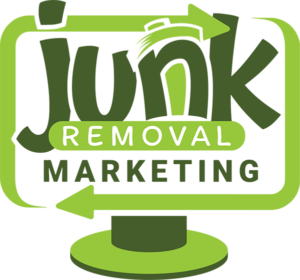Identifying what your customers want is the secret to running a thriving junk removal or dumpster rental business.
I conducted a survey of over 225 respondents to uncover trends in customer behavior, preferences, and decision-making. From homeownership and household size to whether they prefer full-service junk removal or DIY dumpster rentals, this data is packed with actionable insights to help your business attract and serve the right clients.
Did you know homeowners are far more likely to choose full-service junk removal, while renters often lean toward DIY solutions? Or that most people prioritize convenience over price? These are the kinds of trends that can inform your marketing, pricing, and service offerings.
I’ll break down the survey findings to provide you with a clear picture of what today’s junk removal customers want so you can optimize your services, target high-value clients, and outpace your competition.
Junk Removal Habits: How Often Do Customers Declutter?
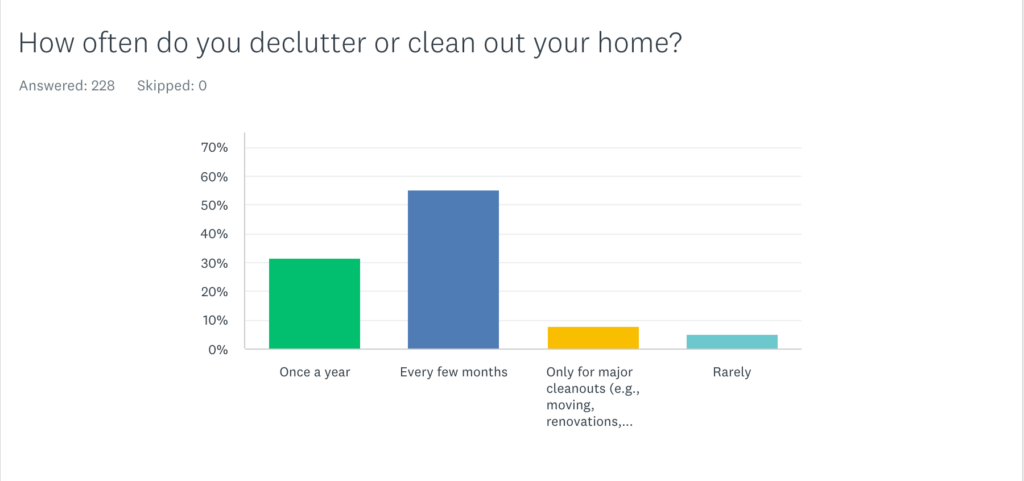
When it comes to decluttering, how often people clean out their homes depends a lot on where they live. According to our survey, 75% of apartment and condo residents declutter every few months, compared to just 48% of those in single-family homes. That’s a big difference—and one that junk removal companies can use to fine-tune their marketing.

For apartment and condo dwellers, frequent decluttering is often a necessity. With less storage space, they don’t have the luxury of stashing away unwanted items for years. Instead, they’re more likely to purge regularly to keep their homes organized. On the other hand, single-family homeowners may have basements, garages, or sheds to store things longer, leading to less frequent cleanouts.
How Junk Removal Companies Can Use This Insight
Rather than using a one-size-fits-all approach, junk removal businesses should tailor their marketing based on home type.
Here’s what I recommend:
- For apartment and condo residents: Promote recurring or seasonal cleanup services. Since they declutter more often, subscription-based junk removal plans—such as quarterly pickups—could be an attractive option.
- For single-family homeowners: Focus on larger, less frequent cleanouts. Messaging around “big decluttering days” or spring/fall cleanups could resonate more with this audience.
By recognizing how decluttering habits vary, junk removal companies can position their services in a way that truly speaks to their customers’ needs.
The Preferred Type of Junk Removal Service: Full-Service vs. Dumpster Rentals
When it comes to getting rid of unwanted junk, most people would rather have someone else do the heavy lifting. Our survey found that 83% of apartment and condo residents prefer full-service junk removal, while 63% of single-family homeowners also lean toward full-service, with 37% opting for dumpster rentals instead.
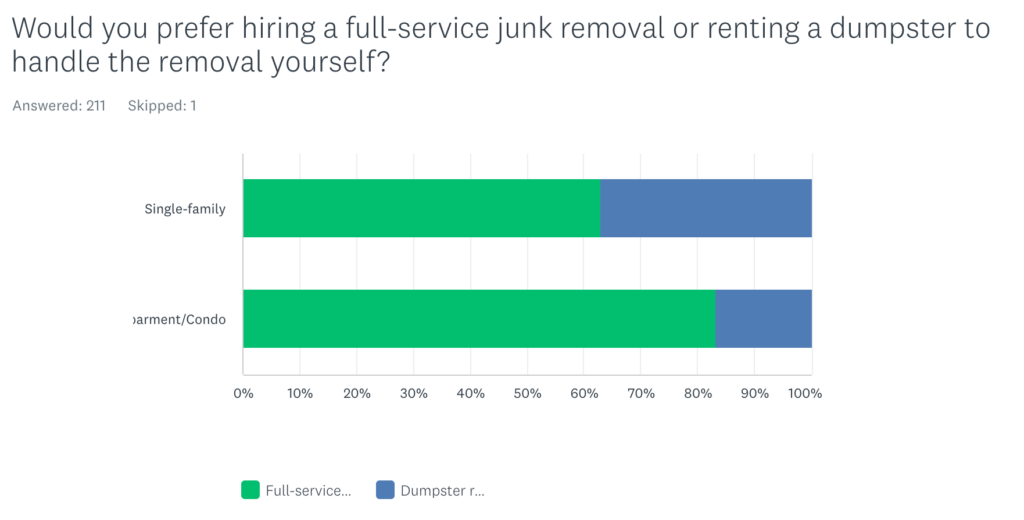
This makes sense when you consider the logistics. Apartment and condo residents often don’t have the space to keep a dumpster sitting outside for days. Plus, many buildings have strict rules about waste disposal. A full-service junk removal company offers them the easiest solution—professionals come in, haul everything away, and it’s done.
Homeowners, however, have a bit more flexibility. With driveways, yards, and more storage space, a dumpster rental can be a practical option for those tackling major home projects at their own pace. But even then, a majority still prefer full-service removal, likely because it saves time and effort.
Framing the Right Message for Customers
To maximize conversions, junk removal businesses should focus on convenience and speed in their marketing for full-service removal. Messaging like “No lifting, no hassle—we handle everything” can appeal to busy homeowners and apartment dwellers alike.
In the same vein, it’s smart to educate customers on the benefits of both options. Some homeowners may be unsure which service is best for them. A clear side-by-side comparison in ads or on a website—outlining the convenience of full-service vs. the flexibility of dumpster rental—can help guide them toward the right choice.
How Customers Search for Junk Removal Services
When people need junk removal, they turn to Google first—and where they click matters. Our survey found that 71% of single-family homeowners use Google to find a junk removal service, making it the dominant search platform for this industry.
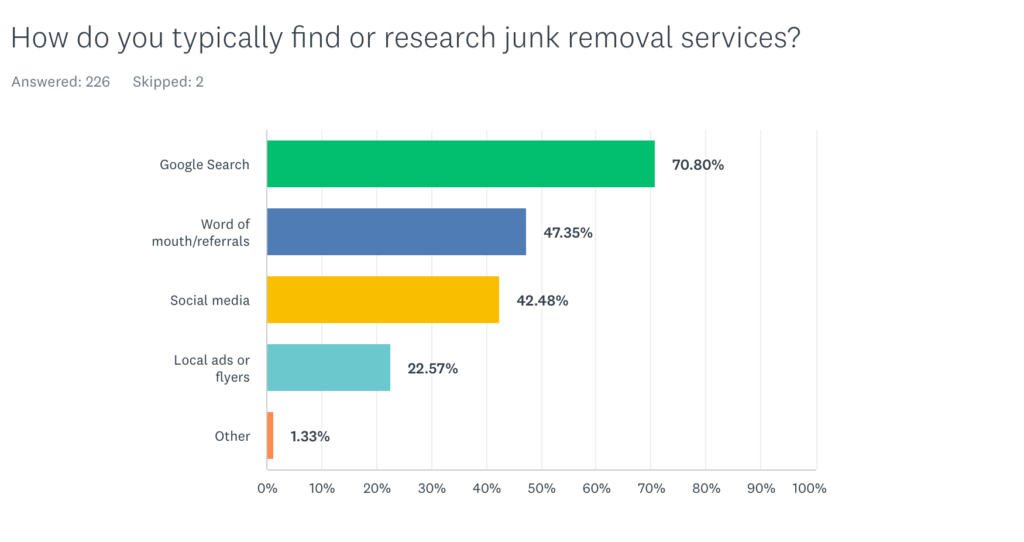
But what’s even more revealing is where they choose to click:
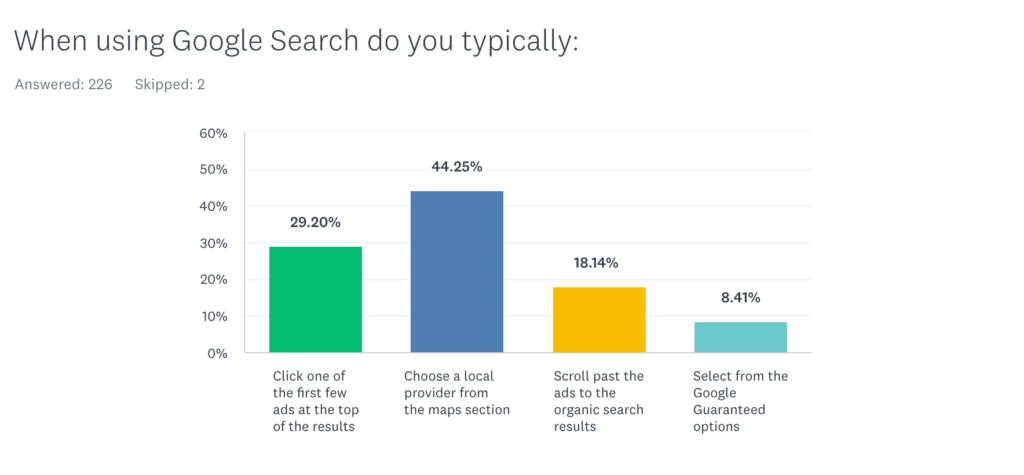
- 44% of junk removal customers pick a business from the Google Maps section (local pack).
- 29% click on one of the first few Google Ads at the top of the page
- 18% go straight for the organic search results
This means that nearly 75% of potential customers make their decision based on the first results they see, whether it’s a paid ad or a local map listing. If your junk removal company isn’t showing up in either of these spots, you’re likely missing out on a huge percentage of potential leads.
How Junk Removal Companies Can Stand Out
To capture more business, junk removal companies need a strong presence in both Google Maps and Google Ads.
- Dominate the Local Pack: A fully optimized Google Business Profile (GBP) is key to appearing in the top three map listings. Companies should focus on getting positive reviews, using local keywords, and keeping their profile updated with accurate service details.
- Maximize Paid Search Results: With 29% of users clicking on Google Ads, a well-structured junk removal PPC campaign can be a game-changer. High-converting ad copy should focus on what customers care about most—fast service, transparent pricing, and eco-friendly disposal.
The Role of Local SEO and Google Maps in Customer Decisions
When people search for a junk removal service, they tend to trust local listings more than traditional ads. Our survey revealed that 44% of all customers choose a business from Google Maps rather than clicking on an ad, and for homeowners, that number is even higher at 76%. This means that being visible in the local map pack isn’t just helpful—it’s essential for attracting customers.
One of the biggest reasons for this preference is trust. Seeing a business in Google Maps, especially one with strong reviews and detailed service information, gives customers confidence that they’re choosing a reliable provider. Unlike ads, which can feel impersonal or sales-driven, a well-optimized Google Business Profile (GBP) signals legitimacy and local expertise.
To stand out in Google Maps, junk removal companies need to focus on profile optimization and junk removal SEO. Keeping a GBP updated with accurate service details, clear pricing, and high-quality photos increases visibility in local searches. Customer reviews also play a huge role—businesses with more positive reviews tend to rank higher and appear more credible to potential clients.
Local SEO strategies also make a difference. Since many people search using location-based terms like “junk hauling in Philadelphia, PA,” companies should ensure these keywords are naturally included in their website content and GBP description. Expanding service area coverage by listing multiple cities or neighborhoods helps improve rankings for a wider audience.
With Google Maps influencing such a large percentage of customer decisions, junk removal companies that focus on strong local SEO and an optimized business profile will have a clear advantage over competitors who rely solely on ads.
Pricing Expectations: What Are Customers Willing to Pay?
Pricing plays a major role in how customers choose a junk removal service, and our survey shows that willingness to pay varies significantly depending on housing type. While some customers are comfortable paying more for convenience, others are more budget-conscious, especially homeowners.
Among single-family homeowners, 40% prefer to spend $200 or less for a medium-sized junk removal job. Townhouse residents fall into a mid-range category, with 50% expecting to pay between $200 and $400. On the higher end of the scale, 36.67% of apartment and condo dwellers are willing to spend between $400 and $600.
These differences likely come down to lifestyle and space constraints—apartment and condo residents may prioritize convenience over cost, while homeowners and townhouse residents might be more price-sensitive.
Adjusting Pricing Strategies for Different Customers
To convert more leads into paying customers, junk removal companies should adjust their pricing strategies based on housing type. Instead of taking a one-size-fits-all approach, businesses can create tiered pricing structures or package deals that align with customer expectations.
For single-family homeowners who are price-conscious, offering budget-friendly options—such as smaller load sizes or bundled services—can make hiring a junk removal company feel like a smart financial decision. Meanwhile, for apartment and condo residents who are willing to pay more, marketing efforts should highlight speed, efficiency, and hassle-free service as key benefits.
What Drives the Customer Decision? Convenience, Price, and Eco-Friendliness
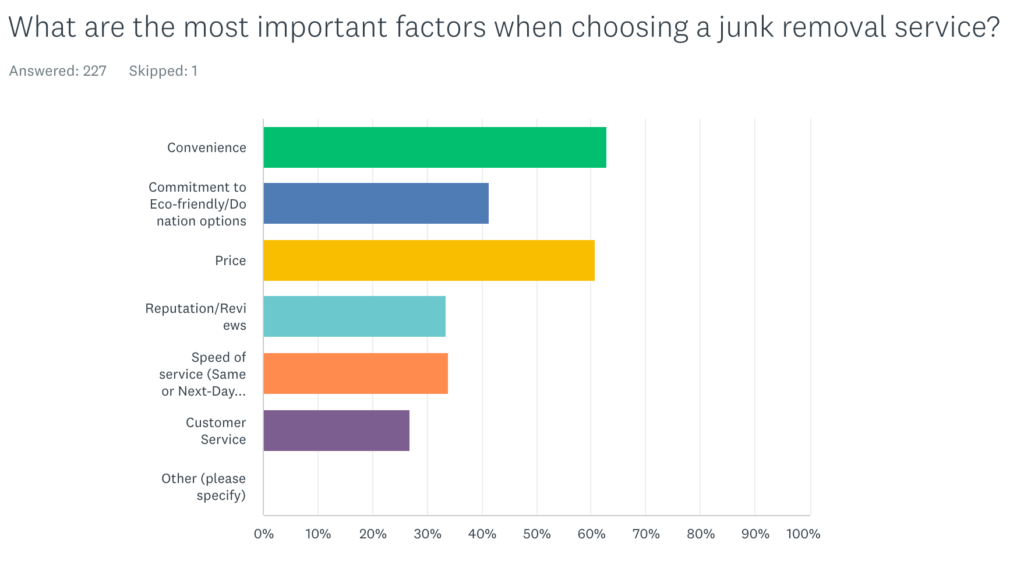
When choosing a junk removal service, customers weigh a mix of factors, but some matter more than others. Our survey found that over 6% of customers base their decisions on convenience and price. A commitment to eco-friendly practices was not far behind at 41%
Crafting the Right Message to Win More Customers
For junk removal companies, this means that marketing efforts should focus on both efficiency and affordability. Customers want a service that’s fast, hassle-free, and fairly priced. Ads and website messaging should highlight quick response times, same-day or next-day availability, and easy online scheduling. The more seamless the process, the more likely customers are to book.
At the same time, price remains a deciding factor, so offering transparent pricing and special promotions can help convert hesitant leads. Junk removal businesses can also stand out by promoting their eco-friendly disposal practices. Many customers appreciate companies that recycle or donate items instead of sending everything to a landfill.
Showcasing these efforts—whether through website content, customer emails, or social media—can build trust and attract environmentally conscious customers.
The Power of Discounts in Driving Conversions
Pricing is a major factor in a customer’s decision, but how a discount is presented can make all the difference.
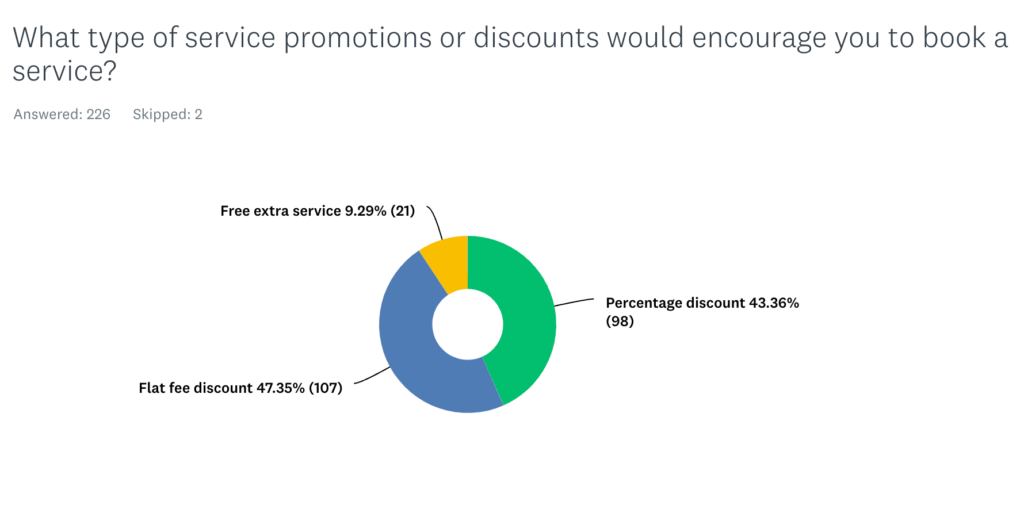
Our survey found that 43% of customers prefer percentage-based discounts, while 47% prefer a flat-fee discount.
However, when I filtered the results for customers willing to pay $400 or more for a medium-sized job, 51% preferred a percentage discount over a flat rate indicating the your ideal customer may be more inclined to book a service with a percentage offer.
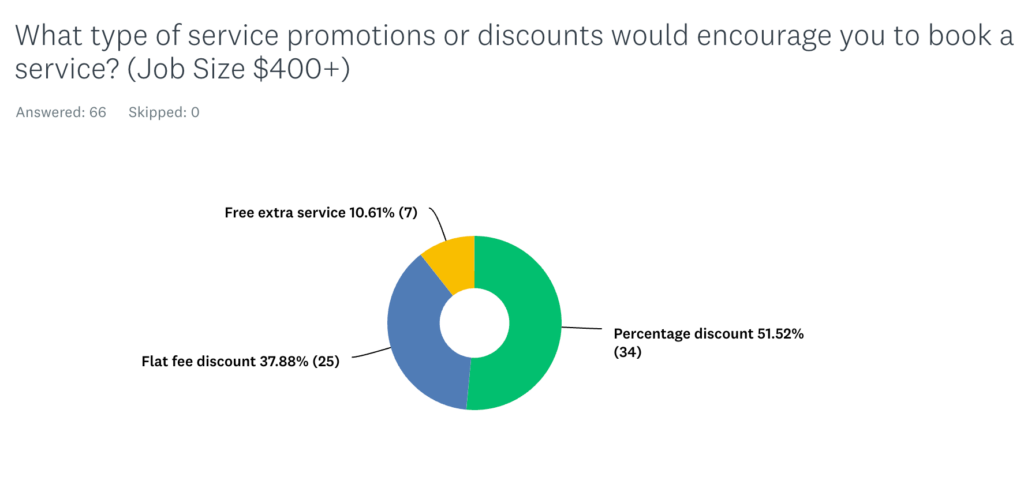
This suggests that different types of customers respond better to different pricing incentives, meaning junk removal companies should be strategic in how they structure their promotions.
Maximizing Sales with the Right Discount Strategy
Rather than applying a one-size-fits-all approach, junk removal businesses should test different discount formats to see what resonates most with their target audience. A/B testing can help determine which promotions drive the most conversions.
For full-service junk removal customers, percentage-based discounts (e.g., “Save 10% on your next junk removal”) tend to be more effective. These work well in email marketing campaigns and customer retention efforts, where a small percentage off feels like a great deal without undercutting the perceived value of the service.
On the other hand, single-family homeowners are more likely to respond to flat-fee discounts (e.g., “$50 off your junk removal job”). This type of promotion is ideal for landing pages and paid ads, as it provides a clear, straightforward savings amount that appeals to cost-conscious homeowners.
How Fast Do Your Customers Want Their Junk Removed?
For many customers, junk removal isn’t something they plan far in advance—it’s something they need right away. Our survey found that 39% of full-service junk removal customers want their items removed immediately, whether they’re clearing out space for a move, dealing with an unexpected cleanup, or simply tired of the clutter, speed matters.
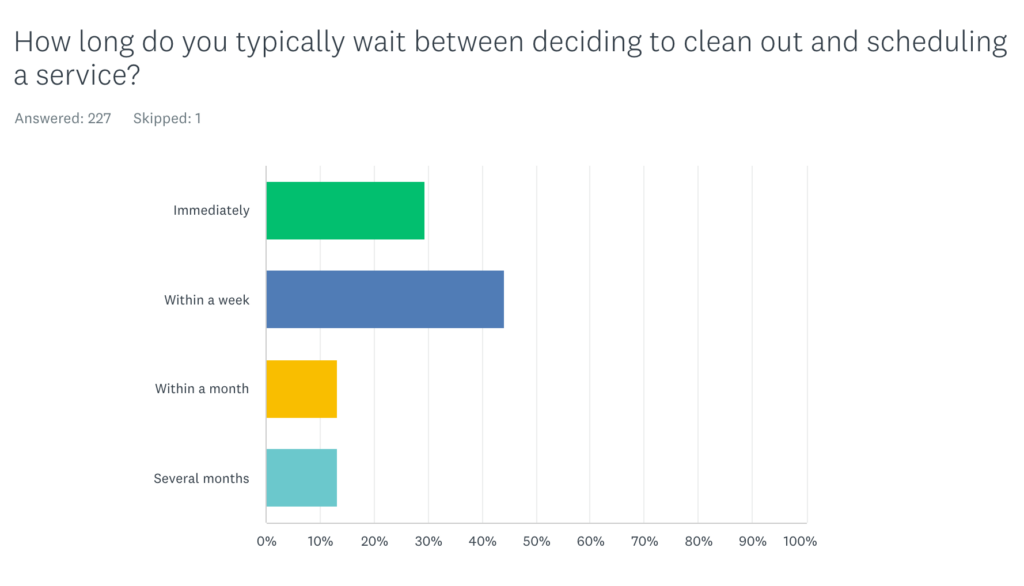
Capturing Last-Minute Customers with Fast Service
Junk removal companies that highlight same-day or next-day availability in their marketing will have a significant edge. Customers searching for junk removal services often want a quick solution, so emphasizing speed and convenience in website messaging, ad copy, and social media can make a big difference.
Google Ads is another powerful tool for capturing high-intent, urgent leads. Running campaigns with phrases like “Same-Day Junk Removal Available” or “Fast, Reliable Junk Hauling Near You” can attract customers who need immediate assistance. Having a clear call-to-action, such as “Book Now for Same-Day Service,” can also help convert website visitors into paying customers.
For junk removal companies, speed isn’t just a selling point—it’s a decision-maker. Businesses that position themselves as fast, reliable, and easy to book will win over customers who don’t want to wait.
Online Booking vs. Traditional Scheduling: How Do Customers Prefer to Get a Quote?
Convenience plays a big role in how customers choose a junk removal service, and that extends to how they prefer to get a quote.
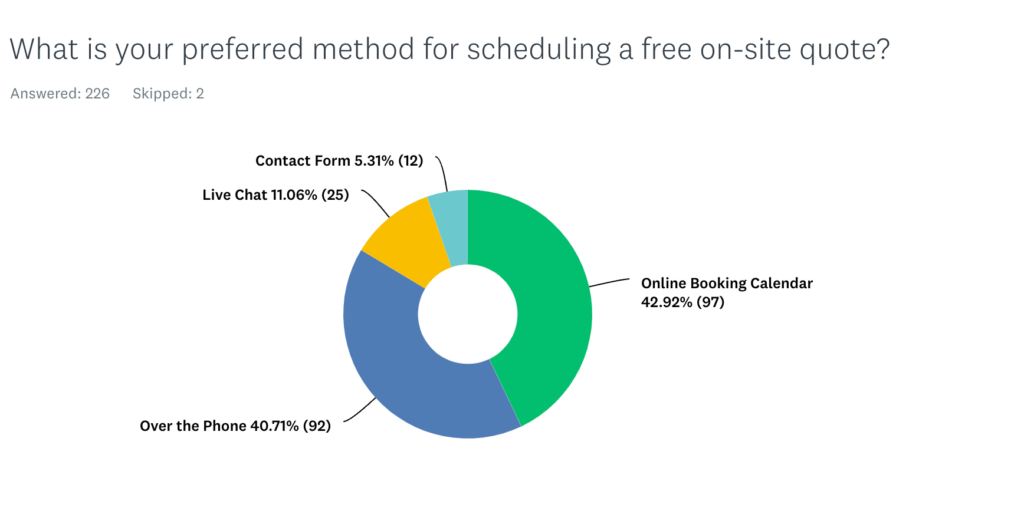
Our survey found that 43% of customers prefer using an online booking calendar, making it the most popular choice for this group. The next most preferred contact option was a phone call at nearly 41%.
So, what does this mean for you?
Most importantly, have clickable and easily accessible phone numbers on your website.
Also, if you use a system like Workiz, leverage their online booking abilities to your advantage.
Making Scheduling Easy for Every Customer
Since different types of homeowners have different preferences, junk removal companies should offer multiple scheduling options to accommodate all customers. A well-optimized online booking system is essential, especially for single-family homeowners who want a quick and easy way to secure a quote. The booking process should be fast, intuitive, and mobile-friendly, allowing customers to choose their preferred time slot without hassle.
At the same time, businesses shouldn’t rely on online scheduling alone. Many townhouse residents, along with other demographics, still prefer more traditional scheduling methods. Providing a dedicated phone line, text-based scheduling, and an easy-to-use contact form gives customers the flexibility to book in the way that feels most comfortable for them.
Who Spends the Most? High-Ticket Customers and How to Target Them
Not all junk removal customers are looking for the cheapest option—some are willing to spend hundreds of dollars for a hassle-free, full-service experience. Our survey revealed that 100% of people spending $600 or more prefer full-service junk removal, making them ideal high-ticket customers.
Where these customers come from is just as important. 55% of people who click on Google Ads spend $600 or more, while 42% of those who choose a business from Google Maps spend between $400 and $600. This means that customers who engage with paid listings and Google Guaranteed options tend to have higher budgets, making them prime targets for junk removal businesses looking to maximize revenue.
Attracting and Converting High-Ticket Customers
To capture these big spenders, junk removal companies should invest heavily in Google Ads and Google Guaranteed listings. These platforms attract customers who are actively searching for a service and are ready to book. Running ad campaigns that emphasize premium, full-service junk removal—with messaging like “Fast, Reliable, and Stress-Free Junk Removal”—can help position a company as the top choice for customers who value convenience over cost.
Another way to increase revenue per job is by offering premium service packages. These could include perks like same-day service, white-glove removal, or eco-friendly disposal guarantees. When high-intent customers see these options, they’re more likely to spend more for a higher level of service.
Turning Customer Insights into Junk Removal Success
The way people search for and choose junk removal services isn’t random—it follows clear patterns. Some customers want the cheapest option, while others are willing to pay more for speed and convenience.
Knowing these differences can help junk removal businesses fine-tune their pricing, marketing, and services to attract the right clients. The companies that listen to their customers and adapt will be the ones that win more business and keep them coming back.
Want to maximize your inbound leads with data-driven insights? Schedule a free discovery call today!
